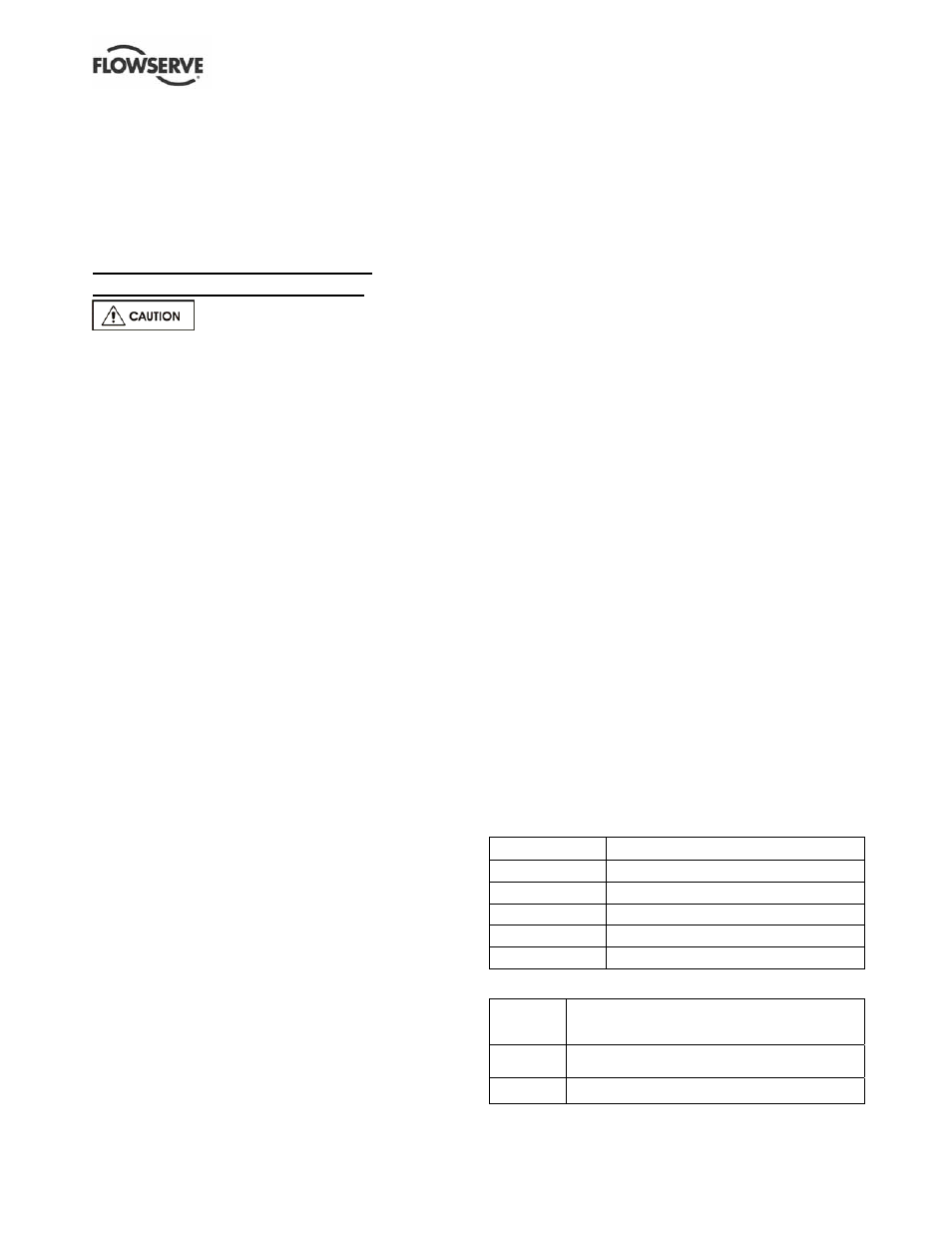5 commissioning, startup, operation and shutdown, 1 pre-commissioning procedure, 2 pump lubricants – Flowserve S-series PolyChem User Manual
Page 24

USER INSTRUCTIONS POLYCHEM S-SERIES ENGLISH 71569207 11-08
Page 24 of 52
flowserve.com
If leakage of product from the pump or its associated
sealing system can cause a hazard it is recommended
that an appropriate leakage detection system is installed.
To prevent excessive surface temperatures at
bearings it is recommended that temperature or
vibration monitoring are carried out.
5 COMMISSIONING, STARTUP,
OPERATION AND SHUTDOWN
These operations must be carried
out by fully qualified personnel.
5.1 Pre-commissioning procedure
5.1.1 Pre start-up checks
Prior to starting the pump it is essential that the following
checks be made. These checks are all described in
detail in the Maintenance section of this manual.
• Pump and motor properly secured to the baseplate
• All fasteners tightened to the correct torque
• Coupling guard in place and not rubbing
• Rotation check, see section 5.4.
This is absolutely essential
• Impeller
clearance
setting
• Shaft seal properly installed
• Seal support system operational
• Bearing
lubrication
• Bearing housing cooling system operational
• Pump instrumentation is operational
• Pump is primed
• Rotation of shaft by hand
As a final step in preparation for operation, it is
important to rotate the shaft by hand to be certain that
all rotating parts move freely, and that there are no
foreign objects in the pump casing.
5.2 Pump lubricants
5.2.1 Oil bath
The standard bearing housing bearings are oil bath
lubricated and are not lubricated by Flowserve.
Before operating the pump, fill the bearing housing to
the center of the oil sight glass with the proper type
oil. (See Figure 5-1 for approximate amount of oil
required - do not overfill.)
An optional oil slinger is available. The oil slinger is
not necessary; however, if used, it provides an
advantage by allowing a larger tolerance in
acceptable oil level. Without an oil slinger, the oil
level in the bearing housing must be maintained at
±3 mm (±
1
/
8
in.) from the center of the sight glass.
The sight glass has a 6 mm (¼ in.) hole in the center
of its reflector. The bearing housing oil level must be
within the circumference of the center hole to ensure
adequate lubrication of the bearings.
See Figure 5-2 for a general description of the lubricants
to be used and Figure 5-7 for recommended lubricants.
DO NOT USE DETERGENT OILS. The oil must be
free of water, sediment, resin, soaps, acid and fillers of
any kind. It should contain rust and oxidation inhibitors.
The proper oil viscosity is determined by the bearing
housing operating temperature as given in Figure 5-3.
To add oil to the housing, clean and then remove the
vent plug [6521] at the top of the bearing housing, pour
in oil until it is visually half way up in the sight glass
[3855]. Fill the constant level oiler bottle, if used, and
return it to its position. The correct oil level is obtained
with the constant level oiler in its lowest position, which
results in the oil level being at the top of the oil inlet pipe
nipple, or half way up in the sight glass window. Oil
must be visible in the bottle at all times.
Note that on ANSI 3A™ power ends there is no
constant level oiler. As stated above, proper oil level is
the center of the “bull’s eye” sight glass [3856].
In many pumping applications lubricating oil becomes
contaminated before it loses its lubricating qualities or
breaks down. For this reason it is recommended that
the first oil change take place after approximately 160
hours of operation, at which time, the used oil should be
examined carefully for contaminants. During the initial
operating period monitor the bearing housing operating
temperature. Record the external bearing housing
temperature. See Figure 5-4 for maximum acceptable
temperatures. The normal oil change interval is based
on temperature and is shown in Figure 5-5.
Figure 5-1: Amount of oil required
Pump
Mark 3A and ANSI 3A
Group A
458 ml (15.5 fl. oz.)
Group 1
251 ml (8.5 fl. oz.)
Group B
946 ml (32 fl. oz.)
Group 2
946 ml (32 fl. oz.)
Group C
793 ml (26.8 fl. oz.)
Figure 5-2: Recommended lubricants
Mineral
oil
Quality mineral oil with rust and oxidation
inhibitors. Mobil DTE heavy/medium (or
equivalent)
Synthetic
Royal Purple or Conoco SYNCON (or equivalent).
Some synthetic lubricants require Viton O-rings.
Grease
MOBIL POLYREX EM (or compatible)
